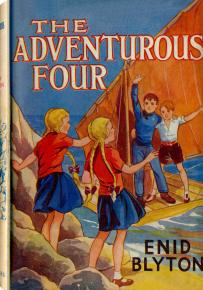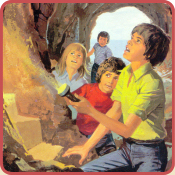
The Adventurous Four

Book Details...
First edition: 1941
Publisher: George Newnes
Illustrator: E.H. Davie
Category: Adventurous Four
Genre: Mystery/Adventure
Type: Novels/Novelettes
Publisher: George Newnes
Illustrator: E.H. Davie
Category: Adventurous Four
Genre: Mystery/Adventure
Type: Novels/Novelettes
On This Page...
Reprints
1. 1962 Armada, illustrations and cover by Dorothy Brook
2. 1967 Merlin, illustrations and cover by Clyde Pearson
3. 1971 Armada, illustrations by Dorothy Brook, cover uncredited
4. 1972 Dean, illustrations and cover uncredited
5. 1980 Beaver, illustrations by Trevor Parkin, cover by David Barnett
6. 1984 Dean, illustrations and cover uncredited (*)
7. 1986 Beaver, illustrations by Trevor Parkin, cover by Josep Maria Miralles
8. 1987 Dean, illustrations and cover uncredited
9. 1994 Dean, illustrations uncredited, cover by David Kearney
10. 1998 Collins, not illustrated, cover by Katie Vandyck
11. 2003 Award, illustrations and cover by Gavin Rowe
2. 1967 Merlin, illustrations and cover by Clyde Pearson
3. 1971 Armada, illustrations by Dorothy Brook, cover uncredited
4. 1972 Dean, illustrations and cover uncredited
5. 1980 Beaver, illustrations by Trevor Parkin, cover by David Barnett
6. 1984 Dean, illustrations and cover uncredited (*)
7. 1986 Beaver, illustrations by Trevor Parkin, cover by Josep Maria Miralles
8. 1987 Dean, illustrations and cover uncredited
9. 1994 Dean, illustrations uncredited, cover by David Kearney
10. 1998 Collins, not illustrated, cover by Katie Vandyck
11. 2003 Award, illustrations and cover by Gavin Rowe

1st edition, May 1941 @ 5/-, illustrated by E.H. Davie

7th edition, March 1952 @ 7/-, first to have a pictorial spine

1st Australian edition published by Angus and Robertson in 1948
re-illustrated cover by an uncredited artist

1st German edition published by Bertelsmann Verlag, Gütersloh, in 1969,
illustrated by Rolf and Margret Rettich, with the title
The Arnold Children are Hunting the Weapon-smugglers

Later German edition published by Bertelsmann Verlag, Gütersloh,
with the title The Bold Four are Hunting the Weapon-smugglers
In Germany the Secret Series and the Adventurous Four became one series,
firstly called 'The Arnold Children' and later 'The Bold Four'
(1 story – 26 Chapters – originally serialised in Sunny Stories September 1940 – February 1941 (SS 191-216))
(notes: The first dustwrapper had a blue line drawing on a white spine, which became a plain white spine in June 1942 @ 5/-. This was changed to a full colour spine in March 1952 @ 7/-)
Brief Summary by Cathy Cunningham: Ginger-haired Tom and his twin sisters Jill and Mary are on holiday on the Scottish coast, in the fishing village where their best friend Andy, a fisher-boy, lives and works with his father. Their holiday plan is to take an exciting boat trip to a nearby island, and camp there, but once out at sea, their plans are turned upside down and they find themselves shipwrecked and in the middle of a thrilling and mysterious adventure...
Full Review (This may contain spoilers):
David Cook's Review
To judge by its title and general tone, this first book appears to have been planned as a one off appearing extremely contemporary of its time. There is only a very brief scene setting and quick sketch of the characters and their backgrounds before the story commences.
The scene is summer on the North-east coast of Scotland and twelve year-old Tom, a small, wiry, red-headed boy and his younger twin sisters Jill and Mary, who have thick golden hair tied in plaits are on holiday in a little fishing village. Says Enid — "Their father was in the Air Force and their mother was with them, knitting hard all day long in the garden of the little white house where they were staying."
Initial readers of the time needed not to be told there was a war on and would have been aware that the reference to the children's mother knitting meant she was likely to be making blankets and clothes to be used in the war effort, and that in all probability the children had in fact been evacuated. The children's individual characteristics are fairly well established. Jill is more impetuous than the more thoughtful Mary, and Tom is always hungry, particularly for sausages. The latter's build and appearance is in marked contrast to the other member of the titular quartet.
This is Andy, the fisher boy, a big strong lad of fourteen, dark haired, blue eyed and sun tanned who works with his father in the fishing fleet. Enid tells that he "knew everything about the sea, boats and fishing" and "could mimic any seabird and call the wild gulls to him by crying to them". This immediately establishes him as a leader figure in a relationship to the other three children that not only recalls Jack of The Secret Island — the build up to the leader character and listing of his virtues is virtually identical — but predicts elements of later Blyton characters like Tassie in The Castle of Adventure and the Five's George and Ragamuffin Jo.
Already prior to ones first meeting of the characters Andy has taught the other children to "swim like fishes, to row strongly and to climb the rocky cliff like cats". Although she is ignorant of exactly how it was achieved Andy's tutelage has convinced the children's mother they are safe around him, and the boy's fisherman father is confident enough of his son's abilities to allow him to take the other three away for a few days sailing trip to Little Island. As with The Secret Island's Jack, Andy's lower class status gives him more resilience, experience and street wisdom to combat the ordeals the children will face.
Before they even start their trip the individual characteristics of the two boys make impressions that will have a bearing on the future. Tom's insatiable appetite means they have a surplus of food, which will prove providential, and on the morning of their departure, Andy is convinced a storm is due shortly, but inadvisedly lets the others' enthusiasm for the trip overrule his instincts.
Predictably Andy's fears come to pass. The sky goes coppery, the sea turns blue-brown and then the wind drops and the sea becomes calm and oily. Then the storm strikes and while they are struggling to take in the sail, the wind tears it away. In this book the story is told in brief broad strokes. The more graphically elaborate descriptions of later similar stories like the Adventure Series are missing here. With this tale, Enid gives the impression that the conveying of a morale boosting patriotic story has top priority.
Andy sends the twins down into the cabin to protect them from the storm's fury and the two boys face it alone, Tom clad only in his bathing suit. When the storm finally blow south and warm sun and blue skies appear, Tom is able to change into warm clothes.
Andy it seems doesn't feel either the cold or wet and finds out an old sail to replace the lost one. Its said his wet jersey steams in the hot sunshine, but he does not so much as wrap a blanket around himself until his lone watch on the boat at midnight. Strangely enough this odd behaviour doesn't result in a bad cold or aching muscles, but if Andy makes a habit of neglecting himself in this way he's likely to suffer badly from rheumatism and arthritis in later years! Perhaps he becomes heated with his own embarrassment at neglecting to check they had an anchor on board, which results in them piling the boat on rocks when the moon goes behind clouds.
Luckily the rocks are offshore from a desolate rocky island and as the tide is down the children are able to cross the rocks and unload all their belongings from boat to shore. They dry their rugs in the sun and Andy then finally with the others hangs his wet clothes out to dry!
Providentially although the island is now deserted, farmers had previously tried to eke a living there and the children find wild self-seeded potatoes and runner beans which along with wild bilberries and fish from the sea will sustain them. In a sheltered hollow they find the weathered remains of a farmhouse and fashion a home out of an outside shed.
Unusually for Enid, but in keeping with this story, there seem to be a lack of seabirds on the island and we don't get her usual display of expertise found in equivalent stories in her other series. Andy did lead the others to expect plenty of bird life on Little Island. But perhaps some explanation for this is found in the next book, The Adventurous Four Again. Here the setting is Spring and Andy proposes to take the others to see the nesting on the Cliff of Birds, explaining that he couldn't show them the birds during the Summer setting of this present story as they would have finished breeding and gone out to sea.
Enid's obvious intention here is to get on with the story and this she does. Events evolve steadily with no deviation from the story advancement. Having climbed the highest hill on the island, the children discover other islands around them, with the next one conveniently linked to theirs by a line of rocks. We are not specifically told that two lines of rocks advance from their shore, but it must be so as the beach on the opposite island is enclosed by a lagoon, which Enid carefully explains is a sea lake.
Once on the second island, they discover caves on the shore, specifically the Round Cave, where to their amazement they discover a store of food and are nonplussed as to both how and why it is there and how any boat brought supplies there through the lagoon. They soon discover who it belongs to, but Enid has made a gaffe here as she forgets that the tins would have labels, which would have alerted the children immediately.
In quick succession by exploring the second and third islands the children discover enemy seaplanes and submarines hiding there. Enid is strangely coy about talking of the enemy vessels and their markings. She speaks of "the sign of the crooked cross" painted on them as being "the sign of the enemy, the foe of half the world". The words 'swastika', 'German' or 'Germany' are not used at all, and yet every child in the country would have known the meanings of these words at the time the book was published.
Sensibly the children decide to use Tom's camera to record the proof of what they have seen, and the power and retention of Enid's 'undermind' is shown as objects the children brought with them on their voyage are skilfully brought into play. They need to get the evidence home and steal an enemy rubber dinghy in which to escape but unfortunately they are spotted by the enemy and Tom doing something that was to be a habit in this series, mislays his camera and in returning to find it, loses the dinghy and gets captured in the Round Cave.
Back on the first island the other children manage to hide from an enemy search by the unlikely method of putting seaweed and sand over themselves to disguise themselves as rocks. The use of seaweed was a popular idea with Enid as she reused it in The Sea of Adventure, both to disguise children and later on a separate occasion a boat and the latter idea was used again in Five Fall Into Adventure. Here with the help of perching seabirds the ruse works. It's said that Andy hears the approaching men calling to each other and can't understand anything they say. Moments later however, one of the enemy declares that it was plain nobody could be hiding there for the gulls would not stand about as they were if anyone was hiding! The patriotic them comes through here when Andy tells the twins that they have to be brave. They are British children so they have plenty of courage and heaps of ideas.
Andy works out where Tom is held and with the clever and original use of the children's gramophone and the one record surviving from the storm and shipwreck, an unaccompanied lullaby, manages to rescue the boy and yet give the enemy the impression he is still captive. This is another fine example of the ingenuity of Enid's 'undermind'.
On the boys' return to their island, there is another stirring sequence. The children, using the tides to their advantage and despite ingesting much seawater, manage to heave their boat off the rocks and repair it only for the enemy to catch them escaping and remove their boat. Andy is undaunted and comes up with a plan whereby they will demolish their own wooden shelter, blaming the weather and ask the enemy for a tent and use the wood to build a raft that they conceal under the tent. Then the boys set off across the sea for help.
The removal of their boat by the enemy brings forth another patriotic burst from Andy, but this time specifically in favour of his own national race when he shouts after the departing Germans that they won't beat a Scots boy (shouldn't it be Scottish?) whatever they think. Enid does give Andy the odd word or phrase to denote his nationality, but this is completely removed in the latest Collins' issue as is a whole chapter on what happened to the girls when they were left alone on the islands.
In a coincidence that does slightly invoke disbelief the boys are rescued by a seaplane commanded by Tom's father and they return to the islands to save the girls before British Forces attack the enemy lair. A last nationalistic phrase, saying that the enemy aviators are "no match for our pilots" is again cut by Collins. As they escape the spy fighters and war ships on their way to the islands and even when they arrive home they can hear the bombardment of the islands, so Enid redeems herself. In a wholly satisfactory ending the British Government rewards Andy for his heroism by giving him a brand new red sailed boat called "The Andy".
The illustrations by E.H. Davie are consistently good and satisfactory but the vivid artistry of Dorothy Brook in the Armada edition better captures the dramatic action and the characters of the children. These illustrations are hidden by default to ensure faster browsing. Loading the illustrations is recommended for high-speed internet users only.







 Book 1 of 2 in this category
Book 1 of 2 in this category 